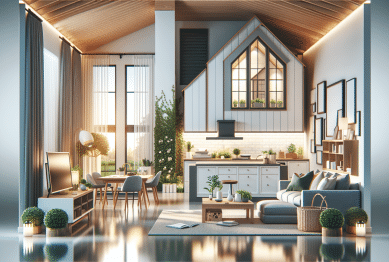Curious about maximizing property value and flexibility? This guide explores how accessory dwelling units (ADUs) can reshape your real estate goals, from rental income opportunities to multigenerational living, and what practical factors you need to consider.
Understanding What Makes ADUs Popular in Housing
Accessory dwelling units, or ADUs, have emerged as a flexible housing solution that fits a broad spectrum of needs. These small, independent residential units are built on the same lot as an existing primary home. What makes ADUs appealing? For many property owners, they provide a way to create extra living space without moving or buying a second property. Interest in ADUs is surging as urban and suburban areas face rising demand for affordable housing options and evolving family structures. The ability for homeowners to build a backyard cottage, basement apartment, or garage conversion can boost housing stock while potentially increasing the value of their property. Zoning updates in many regions are encouraging more people to explore their options, reshaping what homeownership can offer in today’s market (Source: HUD).
Why are cities and counties taking a renewed interest in accessory dwelling units? Population growth, housing shortages, and migration patterns have pushed real estate markets to think creatively. Building new homes can be difficult due to spatial or regulatory constraints, but ADUs offer a path to gentle density. They let homeowners add useful square footage for guests, adult children, or rented tenants. This not only supports multigenerational families but can yield recurring rental income. Homeowners and local governments alike view these living spaces as a practical and scalable answer to today’s housing crunch. As jurisdictions update ADU ordinances, more people learn about costs, financing options, permit rules, and community impacts—steps that help potential builders weigh their choices thoughtfully.
Regardless of the initial motivation—housing relatives, creating a home office, generating passive income—ADUs have become a central part of discussions around resilient, adaptive housing. Experts see them as a tool to offset high mortgage payments and property taxes, or to give older adults supportive aging-in-place options. Stories abound of homeowners converting underused garages and sheds or adding finished apartments above detached garages. The ADU trend illustrates how flexibility, practicality, and value converge in the new real estate landscape, offering creative solutions for varied needs (Source: Urban Institute).
How ADUs Affect Property Value and Real Estate Investments
One consistent question arises: Can adding an ADU boost property value? While results vary by location, condition, and usage, data suggests homeowners may see significant appreciation. An accessory dwelling unit often expands the property’s usable space, making it more attractive for buyers seeking multi-unit flexibility. Rentable ADUs can increase annual income, influencing the market value and buying potential for investors. For those considering long-term real estate strategies, an ADU sometimes transforms a single-family home into a light multifamily asset, opening up new financing options and investment profiles. Some studies indicate that in competitive real estate markets, ADUs offer homes a measurable premium over similar properties without these features (Source: Fannie Mae).
For owners curious about rental income from an ADU, key points include local demand, vacancy rates, and allowable lease types. Some cities restrict short-term rentals, but long-term ADU leasing often provides steady supplemental revenue. That additional cash flow can offset mortgage payments or property taxes, improving overall financial flexibility. In many regions, lenders are gradually adapting underwriting practices to recognize ADU income when considering refinancing or home equity loans. While policies differ, a well-designed and permitted ADU typically delivers tangible and intangible returns, from boosting net operating income to providing peace of mind during unexpected financial moments.
It’s important, however, to balance enthusiasm with realistic expectations. Not every ADU adds value automatically—location, quality, and legal compliance matter. Appraisals may factor in rental potential, but neighborhood comparables without ADUs might influence ultimate market perception. Maintenance responsibilities and property management decisions also play roles in long-term success. Ultimately, learning about recent sales and engaging with experienced real estate professionals can help clarify an ADU’s likely impact in your area and support smart decision-making (Source: National Association of Home Builders).
Exploring Rules and Regulations Before Building an ADU
Before beginning any construction, understanding your local rules and zoning requirements is crucial. Many cities and counties regulate ADU development through special ordinances, covering maximum unit sizes, setbacks, lot coverage, parking, and design. Some areas require owner occupancy of one unit, while others permit both units to be rented. New statewide housing laws in places like California and Oregon have made it easier for homeowners to secure permits, but not all municipalities have updated their codes to match. Navigating these processes often involves reviewing land use policies, talking to planning departments, and sometimes hiring professionals to handle applications and building plans (Source: U.S. Department of Energy).
Zoning isn’t the only regulatory concern. Construction of ADUs must also comply with building codes, utility hookup requirements, and health and safety standards. Fire separation, energy efficiency rules, and accessibility considerations may all be part of your review. Many regions post guides on their websites or offer consultations for homeowners considering an ADU project. Costly mistakes can happen if these steps are overlooked, resulting in delays, extra permit fees, or even removal orders. Some providers recommend assembling a team that includes an architect, engineer, or builder familiar with ADU-specific standards for a smoother process. Preparation pays off by reducing surprises and ensuring compliance.
Financing an ADU build brings its own set of challenges and creative solutions. Traditional mortgage products aren’t always tailored for secondary unit construction, leading many owners to look at home equity lines of credit, cash-out refinancing, renovation loans, or specialty ADU financing options. Grants and pilot programs for affordable housing may sometimes offset construction costs, especially if the ADU will house low-income tenants or seniors. Local governments and housing agencies increasingly publish resource lists, toolkits, and checklists online. Exploring these can reveal both restrictions and funding opportunities relevant to your project (Source: HUD).
Balancing Design, Sustainability, and Usability
The flexibility of ADUs means designs range from compact studio layouts to generous one-bedroom apartments and beyond. Key design decisions revolve around privacy, light, access, and integration with the main home. Many owners emphasize separate entrances, efficient layouts, and careful site placement to blend comfort with privacy. Design trends often include open-concept kitchens, space-saving features, and natural lighting. Eco-conscious homeowners increasingly consider sustainable materials, high-efficiency windows, and renewable energy sources to minimize environmental impact and reduce operational costs. Modern ADUs can rival the comfort of traditional homes and sometimes even exceed expectations for livability. Attention to aesthetics and utility can make an ADU appealing for both short-term guests and long-term tenants.
Universal design and accessibility features are attracting interest as multigenerational living becomes more common. Options such as no-step entries, wider doorways, and thoughtful layout planning create spaces welcoming to individuals of all ages and abilities. These upgrades may cost more initially but can expand the pool of potential users or renters. In regions where aging-in-place is a priority, an accessible ADU can be the difference between staying at home or moving to assisted living. Homeowners sometimes receive incentives or faster permitting for creating ADUs that meet these enhanced standards (Source: AARP).
Durability and low-maintenance planning matter, too. Popular choices for finishes include engineered hardwood or vinyl plank flooring, quartz countertops, and energy-efficient appliances. Homeowners compare the long-term costs of construction with the expected benefits, including projected rental income or increased resale value. Resources from local extension programs, online home design galleries, and municipal ADU showcases reveal inspiring real-world examples and functional hacks. Choosing builders and materials that meet both local requirements and your vision can optimize construction and maintenance, positioning your ADU for long-term usefulness and satisfaction.
ADUs and Community Impact: Affordable Housing and Neighborhood Change
Accessory dwelling units have become a focus for public officials and advocacy groups interested in expanding affordable housing options. By enabling homeowners to add apartments or cottages in existing neighborhoods, ADUs can subtly increase the housing supply without radically altering community character. This approach, known as gentle density, supports more diverse and resilient neighborhoods without the disruption of large-scale new construction. ADUs offer unique strategic advantages where land and available housing are limited but demand is rising. Many believe this extra flexibility can help cities adapt to shifting demographics and create more inclusive, thriving places to live (Source: Pew Trusts).
Affordable housing advocates view ADUs not only as a creative answer to rising prices but as a tool for social stability. When families can keep relatives nearby or generate rental income to cover essential costs, communities may experience fewer displacements and better neighbor relations. Some municipal planners are experimenting with financial incentives or preapproved construction plans to help residents build ADUs faster and more affordably. In many cities, evidence shows these units help stabilize neighborhoods, lessen urban sprawl, and create options for people at different life stages. The result? More connected, adaptable, and economically diverse communities overall.
It’s important to consider trade-offs, too. Critics sometimes express concerns about potential traffic, insufficient infrastructure, or changes in neighborhood feel. Managing parking, maintaining open space, and ensuring adequate water and utilities require thoughtful planning and open public debate. However, careful policy design can balance concerns with the proven benefits of adding flexible housing units. For homeowners and decision-makers alike, understanding community context is central to making ADUs work for everyone, leading to stronger, more responsive neighborhoods over time.
References
1. U.S. Department of Housing and Urban Development. (2022). Accessory Dwelling Units: Case Study. Retrieved from https://www.huduser.gov/portal/pdredge/pdr-edge-frm-asst-sec-081222.html
2. Urban Institute. (2022). How Accessory Dwelling Units Could Help Ease the Affordable Housing Shortage. Retrieved from https://www.urban.org/urban-wire/accessory-dwelling-units-could-help-ease-affordable-housing-shortage
3. Fannie Mae. (n.d.). Growing Demand for Accessory Dwelling Units: How They’re Changing the Housing Market. Retrieved from https://www.fanniemae.com/research-and-insights/perspectives/growing-demand-adus-how-theyre-changing-housing-market
4. National Association of Home Builders. (2023). Special Study: Accessory Dwelling Units. Retrieved from https://www.nahb.org/-/media/NAHB/news-and-economics/docs/housing-economics-plus/special-studies/2023/special-study-accessory-dwelling-units-june-2023.pdf
5. U.S. Department of Energy. (2022). Accessory Dwelling Units: Barriers and Opportunities. Retrieved from https://www.energy.gov/eere/buildings/articles/accessory-dwelling-units-barriers-and-opportunities
6. AARP. (2019). Accessory Dwelling Units (ADUs): A Step by Step Guide to Design and Development. Retrieved from https://www.aarp.org/livable-communities/housing/info-2019/accessory-dwelling-units-adus.html









